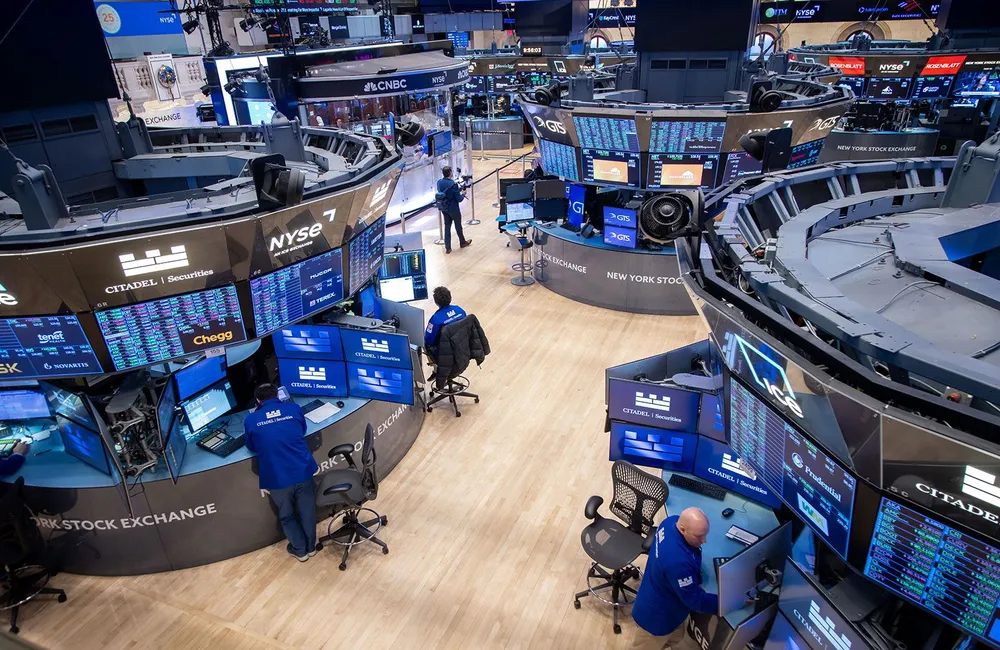The shock wave unleashed by Russia’s invasion of Ukraine rippled across global financial markets on Thursday. Europe’s stocks were left battered by heavy declines, but in the US the picture was more mixed, with many companies insulated from the immediate effects of the conflict.
US stocks bounced back after opening losses, while technology stocks marked a modest recovery from weeks of sell-offs. Financials and consumer-defensive stocks remained in the red on uncertainty over sanctions and a slowdown in consumer spending. Oil and gold prices rose.
Perhaps most importantly for investors in the United States, the turmoil in Ukraine has so far dampened expectations for a more aggressive interest rate increase from the Federal Reserve in March, with more investors now leaning toward a 0.25 percentage point increase in rates, rather than a 0.5 percentage point hike. That’s even though Russia’s actions could further stoke inflationary pressures.
Investors are now faced with a hefty dose of uncertainty. As tough as it can be to read the usual economic winds that buffet markets, geo-political dangers are more opaque.
“I can’t downplay the magnitude of what’s happening. It’s a dark day for Europe and it’s something that hasn’t happened in the post World War II era,” said Andy Kapyrin, co-chief investment officer of RegentAtlantic, a Morristown, New Jersey-based registered investment adviser with $6 billion under management. “Russia will do a lot of damage to its neighbors and a lot of economic destruction to itself.”
“But this is a geopolitical event, and geopolitical events tend to cause a sea change in the world order but little change in the fundamentals of the economy,” says Kapyrin. “History has proven, looking at the Cuban Missile Crisis, the fall of the Soviet Union, 9/11, that there’s an immediate market reaction that is motivated by fear of the unknown, but the markets tend to recover relatively quickly because there isn’t a tremendous amount of impact on major economic fundamentals, particularly in developed countries.
The market’s immediate response on Thursday was to continue a sell-off that began way back in early January on expectations the Fed would speed up the timing and magnitude of rate increases to fight stubbornly high inflation. With the latest declines, U.S. stocks officially entered “correction” territory, a drop of 10% or more from their most recent peak for the first time since the bear market sparked by the pandemic.
David Sekera, Morningstar’s chief US market strategist said some short-term volatility was to be expected depending on the trajectory of events in Ukraine. “The next thing for the markets is to assess what will be the impact of the sanctions the US and its allies will apply against Russia, and how to monitor for signs of more escalation or de-escalation,” he adds.
But for American stock investors, Sekera says their portfolios are fairly insulated. US businesses typically do not have large exposures to either Ukraine or Russia, he adds, “so we are not expecting a great deal of a direct impact on US stocks from the sanctions”. But he adds, “depending on the further sanctions that are bound to be imposed, the risk to the US stocks would be for elevated inflationary costs.”
There is a lot of emotion in play around what Russia’s invasion of Ukraine means for markets, according to James Paulsen, chief investment strategist at institutional research outfit Leuthold Group in Minneapolis. But, he adds, “I think this could be the final washout event of the correction.”
Paulsen cites several sentiment indicators, including the Chicago Board Options Exchange’s VIX index, which measures volatility, and the American Association of Individual Investors sentiment survey, showing investors have turned especially negative on stocks.
“I’m a contrarian. I like pessimism,” Paulsen says.
“The fundamentals underneath this are extraordinarily good,” he says. “We’ve had solid corporate earnings and I believe that continues. Rates continue to rise, but they still remain extremely low by historical standards around the world.”
Technology stocks led a rebound from early losses in the US stock market. Tech names and other stocks of high-flying companies have recently lost ground, due to expectations for higher levels of interest rates.
The response in the bond market was tepid. When world events are in turmoil, it often results in a “flight to quality” investors flocking to the refuge of US Treasury bonds. But yields – which move inversely to prices fell only modestly.
There was some movement in the bond market’s pricing of future rate increases by the Fed. After the latest round of inflation and jobs data, the Fed’s rate lift-off in March became especially aggressive, with expectations now focused on a half-point rise in the federal funds rate, versus previous expectations for a quarter-point increase.
Now, with uncertainty around the economy from Russia’s assault on Ukraine, the chances of a larger rate increase have been dialed back.
“The events of today put cold water on some of the extreme hawkishness we’ve been hearing from some of the Fed governors,” says Ed Yardeni, president and chief investment strategist at Yardeni Research. “They are probably going to taper and do 25 bps in March,” he says. Yardeni also says he believes the Fed will postpone trimming its holdings of bonds that it bought to inject money into the economy during the pandemic recession. However, that reduction — called quantitative tightening had been expected by many market participants to start as early as May or June.
The Fed’s path is still complicated by the possible inflationary effects of the Ukraine conflict. Oil and agricultural prices are rising sharply following today’s invasion, and worries about aggravated supply chain disruptions, especially for palladium, are rising also,” he says. It has a critical metal that accounts for 33% of the world demand needed for catalytic converters in automobiles, he notes, and Russia recently ramped up its percentage of that world demand.
David Meats, Morningstar’s director of research for energy and utilities, does not anticipate any further sanctions that would curtail the supply of oil or natural gas from Russia.
But with oil and natural gas prices already elevated because of tight supply conditions, energy sanctions on Russia would also have an adverse effect on consumers and economies in the US and Europe, according to Morningstar’s Sekera. Russia and Ukraine are two of the world’s biggest producers of wheat, and the ripple effects of military action today could also push food prices up.
“Based on how the situation in Ukraine translates to commodity prices like oil and those inflationary pressures lag economic growth, the Federal Reserve will be forced to continuously reassess the trade off between the risk of increasing inflationary pressures and the potential of higher oil and commodity prices to slow the economy more than anticipated,” Sekera says.





















